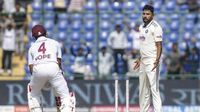The dust has barely settled at the Arun Jaitley Stadium in New Delhi, but the echoes of India’s comprehensive 2-0 Test series sweep over the West Indies are still reverberating through the cricketing world. While the final scoreline suggests dominance, the stories behind the numbers offer a fascinating glimpse into the present and future of Indian cricket—especially when it comes to the emerging talents and the unyielding spirit of the fast-bowling attack.
Let’s start with the man of the moment: Mohammed Siraj. The Hyderabad pacer, often hailed as the cynosure of India’s fast bowling arsenal, delivered performances that belied the often unhelpful nature of Indian pitches, particularly in the second Test. Siraj’s three wickets in New Delhi might look modest on paper, but the conditions made each scalp a significant achievement. "Every wicket (that I took) felt like five wickets," Siraj admitted in a video shared by the BCCI, underscoring just how hard he had to toil for every breakthrough. With the West Indies batters digging in and the pitch offering little to the seamers, Siraj’s persistence and aggression paid off in spades.
It wasn’t just the numbers that stood out. Siraj’s attitude and commitment caught the eye of teammates and fans alike. India’s wicketkeeper-batter N. Jagadeesan, who announced Siraj as the 'Impact Player of the Series' in the team’s dressing room, was effusive in his praise. "Obviously, there have been a lot of performances in this series, great performances, but now it’s just about one guy who has been impeccable throughout this series," Jagadeesan declared. He went on to highlight Siraj’s vigour, courage, and aggression every time he was handed the ball: "Every time he came on, he had the same [attitude], and more importantly, he was probably the one when there was good effort on the field, he was the first one to go and pat everyone on the back and encourage them."
Siraj’s series haul—ten wickets across two Tests, including a seven-wicket masterclass in Ahmedabad—cements his role as a leader of the attack. But for Siraj, the format itself is the biggest motivator. "I feel very proud as a person after any achievement. I will try to continue with such performances because Test cricket is my favourite format," he said. "There are so many challenges in it; you have to be on the field the whole day, and you have to do it physically and mentally. It’s very different but it also makes me feel proud and have fun."
While Siraj’s star continues to rise, the series also threw a spotlight on the fortunes of young Tamil Nadu batter Sai Sudharsan. The 24-year-old was given a golden opportunity at number three, but his returns—scores of 3, 87, and 39—left more questions than answers. The Delhi Test saw Sudharsan finally break through with a near-flawless 87, yet he failed to convert it into a maiden Test century. That, according to former India chairman of selectors Krishnamachari Srikkanth, could be costly.
"I still feel we should wait for some time. He played well, especially off the backfoot, but I wouldn’t say he should be a certainty over the next two to three series so easily. But he should not have let go of such an easy century. There is a big difference between 87, why even 99, to 100," Srikkanth commented on his YouTube channel. The former skipper’s words carry weight in Indian cricketing circles, and his emphasis on the psychological and statistical impact of scoring centuries is a lesson for all up-and-comers. "Once you score that hundred, it’s a different level. 90s, 50s and 70s are of no use compared to a 100. Irrespective of how much you fail, everyone will only ask for the number of hundreds. That’s where Sai Sudharsan missed out."
Sudharsan’s journey is far from over, but Srikkanth’s assessment offers a reality check for those hoping to see him as a fixture in the Test side. The message is clear: potential and talent must be converted into big scores, especially when opportunities come knocking against teams like the West Indies.
On the other end of the spectrum is Yashasvi Jaiswal, the Mumbai opener who continues to impress with his adaptability and attacking flair. Srikkanth was unequivocal in his praise, calling Jaiswal a true all-format player. Despite raising his Test record to world-leading standards, Jaiswal has featured in just a single ODI and was surprisingly omitted from India’s recent Asia Cup T20I squad. His T20 credentials are nothing short of remarkable, boasting a strike rate north of 164.
"100% he (Jaiswal) is an all-three-format player, no two ways about it. T20 his record is brilliant, in ODIs he will do very well but he has not been given ample chances. His game is natural and he plays his natural game without modifying. He is even charging medium pacers and smashing them at times," Srikkanth said. The selectors seem to agree, as Jaiswal is set to travel to Australia for a crucial three-match ODI series beginning October 19, 2025. The series will be a litmus test for the young left-hander’s adaptability and could mark the start of a new chapter in his limited-overs career.
Looking back, India’s 2-0 sweep over the West Indies might seem routine, but it has set the stage for some compelling storylines. The emergence of Siraj as a workhorse and leader, the ongoing debate over Sudharsan’s place in the team, and the anticipation surrounding Jaiswal’s ODI prospects all point to an exciting period ahead for Indian cricket.
With the Australia ODIs looming and the Test team brimming with both experience and youthful exuberance, the next few weeks promise plenty of drama and opportunity. Will Sudharsan seize his next chance? Can Siraj continue to lead from the front on foreign soil? And will Jaiswal finally cement his place as an all-format superstar? For Indian cricket fans, the journey is just getting started.
